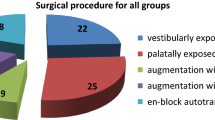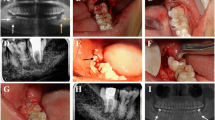Abstract
Repositioning of impacted teeth in the dental arch through en-bloc autotransplantation showed short-term efficacy of 89%. The objective of this study was to evaluate the technique for long-term efficacy. The analysis involved 23 teeth transplanted to the alveolar ridge through harvesting the tooth with the adjacent bone tissue. Development of the root was completed and the apical foramen was closed in all the teeth. The teeth were examined clinically and radiologically (CBCT) and compared to contralateral ones. The obtained data were analysed statistically. The efficacy of the procedure amounted to 81% including two teeth lost at an early stage and another two lost during follow-up. The mean age of patients upon performing the procedure was 29.8. The long-term follow-up amounted to the mean of 34.3 months. In the study group recession of 1–2 mm as well as 3–5 mm was found, which was not noted on the control group. In 11.1% of the study group teeth the external root resorption was observed. No transplanted tooth underwent root canal treatment, no periapical changes were observed at CBCT and 77.8% of those showed positive reaction to ethyl chloride. One case of ankylosis was observed in tooth 11 and in two cases increased mobility of the transplanted tooth was found. Regeneration of nerves as well as revascularization in the en-bloc autotransplantation proceeded with high predictability and the risk of ankylosis of the treated tooth seemed to be negligible. Gingival recession was observed more often in case of en-bloc transplantation compared to the control group. The long-term follow-up suggested that this the technique does not prevent external resorption in 100%.


Similar content being viewed by others
Data availability
The authors declare that data supporting the findings of this study are available within the article and its supplementary information files.
References
Akkocaoglu M, Kasaboglu O (2005) Success rate of autotransplanted teeth without stabilisation by splints: a long-term clinical and radiological follow-up. Br J Oral Maxillofac Surg 43:31–35
Andreasen JO (1981) Periodontal healing after replantation and autotransplantation of incisors in monkeys. Int J of Oral Surg 10:54–61
Arikan F, Nizam N, Sonmez S (2008) 5-year longitudinal study of survival rate and periodontal parameter changes at sites of maxillary canine autotransplantation. J Periodontol 79(4):595–602
Becker A, Chaushu S (2003) Success rate and duration of orthodontic treatment for adult patients with palatally impacted maxillary canines. Am J Orthod Dentofacial Orthop 124(5):509–514
Becker A, Chaushu G, Chaushu S (2010) Analysis of failure in the treatment of impacted maxillary canines. Am J Orthod Dentofac Orthop 137(6):743–754
Chambers IG, Reade PC, Poker ID (1988) Early post-operative endodontic therapy limits inflammatory root resorption of autotransplanted maxillary canine teeth. Br J Oral Maxillofac Surg 26:364–369
Edmunds D, Beck C (1989) Root resorption in autotransplanted maxillary canine teeth. Int Endod J 22(1):29–38
Garcia B, Boronat A, Larrazabal C, Penarrocha M, Penarrocha M (2009) Immediate implants after the removal of maxillary impacted canines: a clinical series of nine patients. Int J Oral Maxillofac Implants 24(2):348
Gonnissen H, Politis C, Schepers S, Lambrichts I, Vrielinck L, Sun Y, Schuermans J (2010) Longterm success and survival rates of autogenously transplanted canines. Oral Surg Oral Med Oral Pathol Oral Radiol Endod 110:570–578
Grisar K, Chaabouni D, Gaitan Romero LP, Vandendriessche T, Politis C, Jacobs R (2018) Autogenous transalveolar transplantation of maxillary canines: a systematic review and meta-analysis. Eur J Orthod 40(6):608–616
Grisar K, Nys M, The V, Vrielinck L, Schepers S, Jacobs R, Politis C (2019) Long-term outcome of autogenously transplanted maxillary canines. Clin Exp Dent Res. 5(1):67–75
Hasselgren G, Larsson A, Rundquist L (1977) Pulpal status after autogenous transplantation of fully developed maxillary canine. Oral Surg Oral Med Oral Pathol 44:106–112
Kallu R, Vincker F, Politis C, Mwalili S, Willems G (2005) Tooth transplantations: a descriptive retrospective study. Int J Oral Maxillofac Surg 34:745–755
Kim E, Jung JY, Chai IH, Kun KY, Lee SJ (2005) Evaluation of the prognosis and causes of failure of 182 cases of autogenous tooth transplantation. Oral Surg Oral Med Oral Pathol Oral Radiol Endod 100:112–119
Krasny M, Krasny K, Wojtowicz A (2020) En bloc autotransplantation of retained canine in the mandible: a case presentation. Int J Periodontics Restor Dent 40(3):403–407
Krasny M, Krasny K, Kamiński A (2021) Aesthetic and functional restoration of the dental arch continuity in difficult cases of impacted teeth within the frontal segment. Cell Tissue Bank. https://doi.org/10.1007/s10561-021-09943-7
Kristerson L (1985) Autotransplantation of human premolars. A clinical and radiographic study of 100 teeth. Int J of Oral Surg 14:200–213
Patel S, Fanshawe T, Bister D, Cobourne MT (2011) Survival and success of maxillary canine autotransplantation: a retrospective investigation. Eur J Orthod 33:298–304
Puricelli E (1987) Treatment of retained canines by apicotomy. RGO 35(4):326–330
Sagne S, Thilander B (1997) Transalveolar transplantation of maxillary canines: a critical evaluation of a clinical procedure. Acta Odontol Scand 55(1):1–8
Schwartz O, Andreasen JO (1988) Allotransplantation and autotransplantation of mature teeth in monkeys: the influence of endodontic treatment. J Oral Maxillofac Surg 46:672–681
Uslu O, Akcam MO, Evirgen S, Cebeci I (2009) Prevalence of dental anomalies in various malocclusions. Am J Orthod Dentofac Orthop 135(3):328–335
Acknowledgements
This research received no external funding
Author information
Authors and Affiliations
Corresponding author
Ethics declarations
Conflict of interest
The authors declare that they have no conflict of interest.
Additional information
Publisher's Note
Springer Nature remains neutral with regard to jurisdictional claims in published maps and institutional affiliations.
Rights and permissions
About this article
Cite this article
Krasny, M., Krasny, K. & Wojtowicz, A. Long term outcomes of en-block autotransplantation of a tooth. Cell Tissue Bank 24, 67–73 (2023). https://doi.org/10.1007/s10561-022-10017-5
Received:
Accepted:
Published:
Issue Date:
DOI: https://doi.org/10.1007/s10561-022-10017-5




